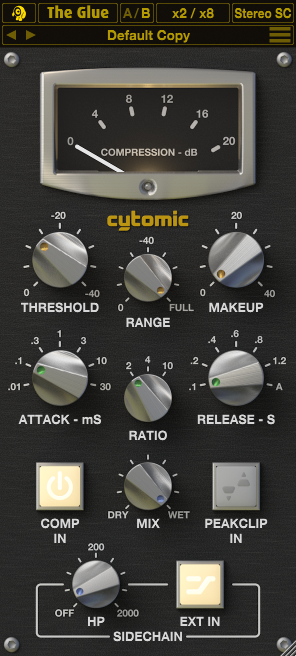The use of sidechain compression on various elements of club tracks is these days fairly well prolific. Given that fact, you might wonder why I’m posting about sidechain compression of basslines… a fundamental technique, that’s been used in club music for years. Whilst it’s a well known technique, it’s also not always easy to execute, nor to judge whether you’ve achieved the correct effect. Hence I wanted to document a few notes about my typical approach to sidechaining basslines, and a real example from a recent track.
The first thing to note is that it’s very hard to give ‘ballpark’ settings for bassline sidechain compression. Appropriate settings depend a lot on the tonality of the kick drum, and moreso the pattern of the bassline. If I’m trying to come up with initial settings for the compressor, I tend to think about it analytically, along the lines of the following. ..
- Fundamentally, you want to avoid having the bassline and bass drum overlap by playing the same frequency range at the same time. I aim to set the compressor to compress the bassline where any such overlapping exists.
- As bass drums typically start with a higher frequency attack (e.g. click) and then quickly descend in pitch to a low drone as they decay, the decay portion is typically where you need to be careful of overlapping the bassline.
- The attack and release parameters are important as they’ll typically contribute a lot to the feel or groove of the bass. For example if your bassline notes are sounding at the same time as the decay of the kick, you’ll typically want to use a fast attack setting, so the compressor is engaged quickly when the drum and bassline notes overlap. Conversely, if the bass drum and bassline notes are more separated in terms of timing (i.e. little overlap), a slower attack setting might provide a more natural sound.
- Depending on how quickly a bass drum hit sounds after a preceding bassline note will similarly contribute to the release setting. As with the attack setting, generally the greater the overlap of notes in this regard, the quicker release setting you might want to use.
- EQ filtering of the sidechain input from the bass drum can sometimes be useful to prevent certain frequency ranges from triggering the compressor. E.g. if the pitch of your bassline is relatively high compared to the drum, you may want to apply some high pass filter to the sidechain input, so that the low frequency parts of the bass drum don’t trigger the compressor (if the bassline is relatively higher pitched, there should be less overlap at the lower frequencies)
That said, I usually use the above thinking as a guide only, and ultimately the sound and feel/groove should determine the final settings. This is a case where it’s highly preferable to use monitors with a sufficient low frequency response, so you can really hear (and/or feel) the effect of the sidechained compression.
For my track ‘Cantana 1‘, I used the following settings…

The controls which don’t have marked scales were set as follows…
Sidechain HP: 29Hz
Threshold: -12.6dB
The bassline in this track was very much a ‘drone’ type sound, rather than having clearly separated, distinct notes. Because of this, there was not much (if any) natural gap between the bass drum hits and the bassline notes. Hence I lent towards fast attack and fast release settings to try and maximize the separation between the two parts (i.e. avoid the aforementioned ‘overlap’ as much as possible). I started out with a fairly fast release setting also to try and make the initial attack of the bass drum more isolated, and more prominent. The threshold and ratio were set by ear… I just kept adjusting both until I achieved what I thought gave the best balance between the levels of the bass drum and bassline. I.e. I wanted to strike a balance between…
- Not having too much compression so that the bassline level was pushed down too far with each drum hit.
- Not having too little so that the two sounds were too smeared and indistinct.
The final attack and release settings were also set by just auditioning various combinations and deciding which gave the best rhythm and feel (after starting with the dials on the faster end of the scale, as mentioned).
Before and after audio clips of the 2 parts soloed are below (again you’ll need headphones or monitors with adequate bass response to properly hear the difference)…
Without sidechain compression
With sidechain compression
Although the audible difference is fairly subtle, the bassline’s waveform changes considerably…

